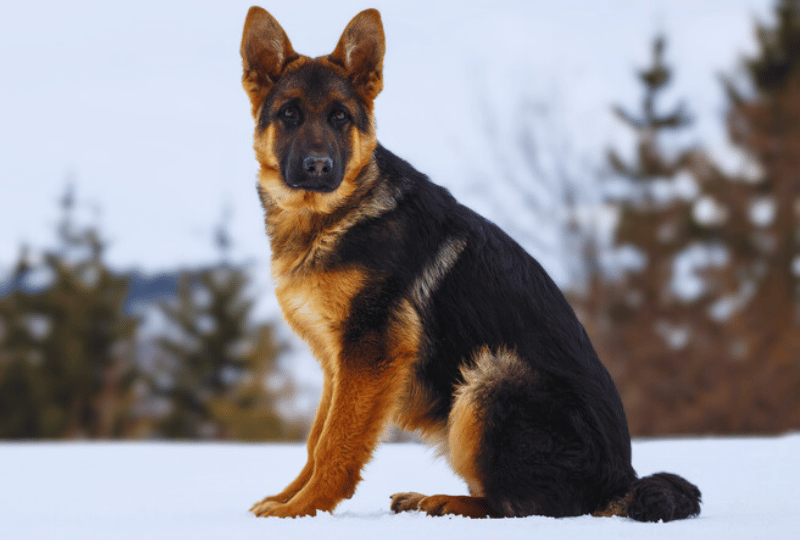German Shepherds usually do well in colder weather. Their coat keeps them warm, and their adaptable and athletic nature means they can tolerate a colder environment with only minimal adjustment. Like most dogs, they cannot tolerate the cold for extended periods of time without protection, and puppies should be kept in warmer areas.
In the article below, we’ll look into the reasons why a German Shepherd is a good choice for living and playing in colder environments, as well as some reasons to think about that might make it more difficult for your German Shepherd to thrive in the cold.
We’ll also discuss how much cold tolerance a German Shepherd has, and how the needs of German Shepherd puppies differ from that of adults. Finally, we’ll discuss some tips on how to keep your German Shepherd warm in even the harshest of weather conditions.
Do German Shepherds Do Well In Cold Temperatures?
Yes, German Shepherds generally do well in colder temperatures. As their name suggests, the breed originates from Germany, which can have temperatures as low as -5 °F (-20 °C) in certain parts, and generally doesn’t get much warmer than 37 °F (3 °C) during the winter months.
As a working dog breed, German Shepherds were expected to continue their work even in the harshest of weather conditions. While the breed historically lived in a colder climate, there are several other reasons that contribute to the German Shepherd’s hardiness in colder temperatures even if they aren’t the working dog of the past.
3 Reasons A German Shepherd May Do Well In The Cold
Coat Type
German Shepherds have three distinct coat types: the Stock (Short) Coat, Plush (Medium) Coat, and the Long Coat. They have what is called a double coat, where a softer undercoat is protected by a thicker, more water repellent topcoat called the guard coat.
This dual-layer protection allows them to tolerate colder temperatures and allows them to deal with rain and snow a little bit better than breeds that do not have a double coat.
The long-haired German Shepherd is particularly well-suited to staying warm in colder temperatures, though they may have more difficulty repelling water and snow as their guard coat is not quite as bushy as those of the plush or stock coats.
Adaptability
While some breeds can’t adapt to things very easily, including changes in temperature, the German Shepherd is not usually one of those.
Shepherds tend to be very adaptable to weather and temperature changes, which makes it likelier that they can tolerate sudden drops in temperature or be exposed to colder temperatures for longer periods of time (such as during a day hike).
Their inherent work ethic and willingness to please their owner also add to their ability to adapt to new conditions quickly and without much fuss.
Athleticism
This breed tends to be very athletic and capable of handling a wide variety of terrains, including those often slippery and wet terrains that come along with cold weather.
The German Shepherds athleticism and high energy can help them work through colder weather patterns and allow them to engage in more cold weather activities compared to some other breeds of dogs.
Properly conditioned, a German Shepherd may even be able to accompany their owner on some of the harsher winter activities available, such as snowshoeing or hunting.
3 Reasons Why A German Shepherd May NOT Do Well In The Cold
Coat Type
While the German Shepherd’s double-coat does make it so they can tolerate colder temperatures better, it does NOT mean that the coat tolerates water and wet conditions well.
Unlike some other breeds that were developed for use around water, a German Shepherd’s coat is not very water-repellent. They can stay wet for a long time, which can be dangerous in cold weather conditions. Dr. Nita Patel explains “Because of their double coat, it can take longer for a German Shepherd to dry. For this reason, they need to be monitored and dried diligently when wet.”
Vigorous drying is required, especially around the feet, ears, and face where ice crystals can develop quickly and cause frostbite.
The paws of a German Shepherd (which aren’t webbed and do not contain a lot of insulating hair) are also prone to frostbite if ice and snow are not removed frequently and continuously throughout their time outside, so in harsher conditions boots may be recommended to avoid injuries to the feet.
Ears
If you look at a lot of breeds that were bred to live and work in very cold conditions, their ears are generally closer to their head (they have a droopy ear compared to an erect ear), and/or they have thick fur around the ear and thicker skin on the ear itself.
German Shepherds (which are known for their large, bat-like ears) do not really have a lot of insulation around their ears. The ears are generally thin-skinned, with little to no thick fur around the ear.
This makes it more likely your German Shepherd’s ears will become colder much more quickly than the rest of their bodies, and frostbite could occur.
Maintenance Requirements
While German Shepherds can do well in cold temperatures, they do tend to require more maintenance than those breeds who were specifically bred for use in extreme temperatures.
This is truer for very harsh conditions in which heavy snow or freezing temperatures are frequent, or if their owner spends a significant amount of time outdoors during the winter and would like their pup to accompany them.
Periodically pausing to clean off snow-pack from a German Shepherd’s paws, face, or ears might interrupt their owner’s activities, as can the time it takes to fully dry their dog off once they’ve returned home.
Veterinarian Nita Patel also explained that “Unlike some other cold-weather ready breeds (like the St. Bernard or the Newfoundland), the German Shepherd may require additional caloric supplements in colder weather to help them maintain a higher body temperature. This is especially true if they are working outside or having high levels of activity.”
In extreme or very wet temperatures, you may also need to purchase additional supplies for your German Shepherd such as a waterproof coat, boots, goggles, or a warmer bed.
What Temperature Is Too Cold For A German Shepherd?
This is dependent on the individual German Shepherd and their age and health. Other weather factors also play a part, as a dry cold is different than a damp cold, and wind chill can also play a role.
For your average healthy adult German Shepherd, they can do well in temperatures as low as 20 °F (-6.7 °C), however at that point, they’ll likely need additional covering such as a coat or boots, and they should only be outside for a very short period of time.
While the breed originates from a colder country, they do not share the same characteristics as many other cold-tolerant breeds do, thus they cannot stay out in the cold for as long as some of those other breeds might (like the Great Pyrenees).
German Shepherds may be able to tolerate colder temperatures indoors (such as in a dog house, garage, or other enclosed area) for a longer period of time provided they are kept dry and away from wind chill.
They may also do well in a crate in a colder space, especially if they have a warm, dry bed and the crate is covered and protected from any wind chill or precipitation.
Senior German Shepherds or those Shepherds who have an underlying health condition or who are recovering from illness or injury are not able to tolerate cold temperatures for more than a few minutes, and even then, they should have some sort of protection on (such as a coat or sweater) and should be dried immediately upon returning inside. If they stay wet and cold for too long, they could develop serious illness.
Do German Shepherd Puppies Do Well In The Cold?
Like senior or sick dogs, German Shepherd puppies may only tolerate colder temperatures for very short periods of time. Newborns and those under six months of age need to be kept warm at all times and should never be exposed to cold temperatures.
For older puppies, they may not be able to tolerate temperatures like an adult German Shepherd would, but they can enjoy trips out in the snow or a short walk in colder rain (though you must make sure to dry them fully upon returning home!).
Younger German Shepherds are still growing in their adult coats, so they do not have the same protection from the elements. They are also still developing physically and mentally, and they may not be able to adapt to cold or wet temperatures like an adult dog would.
How Do I Keep My German Shepherd Warm In Cold Temperatures?
If you live in a colder climate or if you plan on taking your German Shepherd on some adventures that involve colder weather, there are a few ways you can help make sure they are kept warm and comfortable.
It’s always a good idea to have a jacket or sweater on hand during the winter months to help keep your pup dry on particularly nasty days. If you live in a climate where it rains a lot, a waterproof coat is a must.
If you do not have a backyard and you need to walk your dog frequently, making sure they are kept warm is important in keeping them healthy. If your pup has sensitive paws or if they walk in areas with hard snow or ice-pack, boots might be a good idea. Providing a warm, dry area within your home will help keep your pup toasty after their time outside.
If your pup stays outside a lot of the time, an insulated dog house filled with straw, a heated water dish, and even a heated bed is a must. If you’ve got a German Shepherd puppy or senior, or if your pup is feeling unwell, be mindful of how long they can tolerate the colder temperatures.
Checking the weather before you plan activities outside is important, as is knowing your own individual dog and their tolerance for the cold. Dogs can also get hypothermia, so knowing the signs of this illness could potentially save your pup’s life.
Just being aware of any signs of general discomfort in your German Shepherd’s body language in the colder weather will help you determine if you need to warm them up a bit more.
Closing Thoughts
German Shepherds are a great choice of dog breed for those who live in colder climates. Their coats keep them warm, however, care must be taken to make sure they stay dry as their coats are not as water-repellent as some other northern-type breeds.
Shepherds are adaptable and capable of adjusting to new environments quickly, and their athleticism and love of being with their owner means they can push through the cold a bit more than some other breeds.
Precautions should still be taken for German Shepherd puppies as they require more warmth than an adult dog, and sick, injured, or senior German Shepherds may also require more mindfulness when it comes to the weather.
Providing a warm, dry area away from the dampness and wind chill is important no matter what, and the use of a jacket, sweater, or booties may be needed in extreme conditions.


